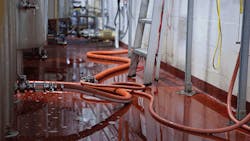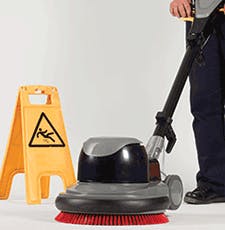Most people don't slip and fall on clean, dry and level floors. Slips, trips and falls to the same level also aren't isolated to a particular area of a facility. They can happen anywhere. The good news is that each injury has root causes that can be readily identified and eliminated to prevent future injuries.
Only about three percent of slip, trip and fall claims are fraudulent, according to a study conducted by the National Floor Safety Institute. Of the remaining 97 percent, some are caused by improper footwear choices, lack of training and poor lighting. However, the primary cause in more than half of slip, trip and fall injuries is a problem with the walking surface.
Walkway audits identify floor safety issues so that plans can be established to eliminate them. Some floor hazards, such as frayed carpeting, loose floorboards or areas where overspray coats a walkway will be fairly easy to find. Others may take a little more work to uncover.
Finding Problems
Because slip-and-fall incidents can occur anywhere, it is important to evaluate each area of the facility and review the actual condition of walking surfaces. Generalities never should be made about a walking surface based on its composition, age or the absence of injuries in the area.
While some surface imperfections are easy to see, each person's perception of whether a given surface is safe may be subjective and biased. A person wearing sneakers and another wearing leather-soled dress shoes while walking on the same surface likely will have different opinions on how slippery the surface it is. Age, gait and experience also can play roles in whether or not a person thinks a surface is safe.
To help overcome personal biases, measure a floor's coefficient of friction during a walkway audit with a tribometer. These devices provide quantitative data that can be used to more accurately evaluate a walking surface and help determine if it may contribute to a slip or fall injury. When tribometers are used as part of routine audits, they also can help determine if a walking surface has changed over time (for better or for worse) and if floor safety plans and cleaning regimens are helping or hindering floor safety efforts.
The following three issues are among the most common floor safety problems that may be identified in a walkway audit:
1. Uneven Walking Surfaces
Floors, walkways, sidewalks and parking lots change over time, no matter how well they are constructed and maintained. Wooden surfaces can bow or develop loose boards. Concrete develops cracks and potholes. Tiles and floor coatings get chipped or wear down. Carpets buckle and fray.
Any of these issues can create uneven walking surfaces that contribute to slips, trips and falls. In fact, variations of as little as one-quarter inch (the thickness of a standard pencil) are enough to cause a trip and fall.
Consider the cost of repairs versus the cost of replacing a walking surface. In some cases, it makes sense to replace a floor – especially if it is not well suited for the application. For example, consider a wood floor in a production area where wet processes are performed daily. Instead of trying to keep the floor even, it may make more sense to replace it. It also may make more sense to replace aged floors than to continue repairing and maintaining them.
When making surface repairs, consider the longevity of the solution that will be used. Even on a very tight budget, spending a little bit more on a long-term solution typically will make more sense than having to do multiple quick patches.
2. Wet and Dry Contaminants
If it has been days or weeks since the last rain or snow, a simple walkthrough may not identify entranceways, aisles, docks, patios, sidewalks or parking lots that are slippery when wet. A single walkthrough, for example, also may not uncover how often workers spill food items while walking back to their offices from the cafeteria.
Both of these scenarios can range from rare to frequent, but they are examples of wet contaminants that need to be addressed in planning. While most solutions are likely to be more involved, some may be as simple as stocking an adequate supply of paper towels in common areas to quickly clean up food spills.
OSHA requires employers to keep floors clean and dry, but it does acknowledge that this isn't always possible or practical. In areas where overspray is common or where wet processes are used, floors are going to be wet, but they don't have to be slippery. Texturized floor finishes, raised grates and absorbent matting are among the solutions that can be used to increase traction in wet areas.
Dry contaminants also present floor safety problems, especially on smooth and sealed surfaces. Dust, shavings, granular coatings, sugar and other similar contaminants are just as likely to cause a slip or fall as wet contaminants. Some can even create fire or explosion hazards. Good housekeeping measures often can solve these problems.
Spills that aren't promptly cleaned up are another common cause of slippery floors and injuries. Stocking spill supplies in areas where liquids are used, dispensed, collected and stored as well as training everyone on how to clean up incidental spills facilitates a fast response. If employees need to go to a remote stock room or supply closet for these items, they are more likely to leave the spill – and the hazard – for someone else to find.
3. Improper Cleaning
Sometimes, improving traction on walking surfaces is as simple as changing how floors are cleaned. If floors are generally in good condition, but finishes don't seem to last or floors continue to have a low coefficient of friction even when freshly washed, evaluate the cleaning methods.
Many facilities have a variety of floor surfaces, from highly polished stone in foyers to tile in hallways and brushed concrete in production areas and warehouses. A common mistake is to use one type of cleaner or cleaning method for all surfaces. This simplifies purchasing, but is probably not the best strategy for eliminating slip, trip and fall hazards.
Flooring manufacturers, cleaning contractors and suppliers of janitorial cleaning chemicals all are great resources for information on how a surface needs to be cleaned and maintained.
After the correct type of cleaning product has been chosen, it is equally important to followthe directions on how to use the product. Using too much of a chemical can cause slippery films to form or damage protective finishes. Using the wrong temperature of water also can negatively affect how the cleaner works.
Another mistake is using dirty mops and water. Correcting this and other common issues can solve many floor safety problems.
Recognizing walking surface problems is an essential step in creating a floor safety program. Because problems with walking surfaces contribute to more than half of all slip, trip and fall injuries, eliminating these hazards will greatly reduce the chance of incidents and help to form the basis for a comprehensive floor safety plan.
Karen Hamel is an EHS specialist and technical writer for New Pig Corp.

